1972年6月16日,大雨開始下過不停。三天之內,天文台錄得共653毫米的雨量,每日雨量超過200毫米,是有紀錄以來6月份連續三日最高降雨量,差不多是全年平均雨量的三成。就在6月18日的中午時分,秀茂坪曉光街對下一幅40米高的填土坡突然崩塌,大量泥土一湧而下,數秒之間淹蓋了臨時安置區內的78間木屋,多達71人死亡。 Starting from June 16, 1972, it rained non-stop for three days with a total rainfall of 653 mm( or over 200 mm per day), making it the highest 3-day total rainfall in June on record and accounting for almost 30% of the average annual rainfall. Around noon on June 18, a 40 meter-high fill slope below Hiu Kwong Street of Sau Mau Ping suddenly collapsed. An enormous amount of debris washed down within seconds, destroying 78 huts in the resettlement area and killing 71 people.
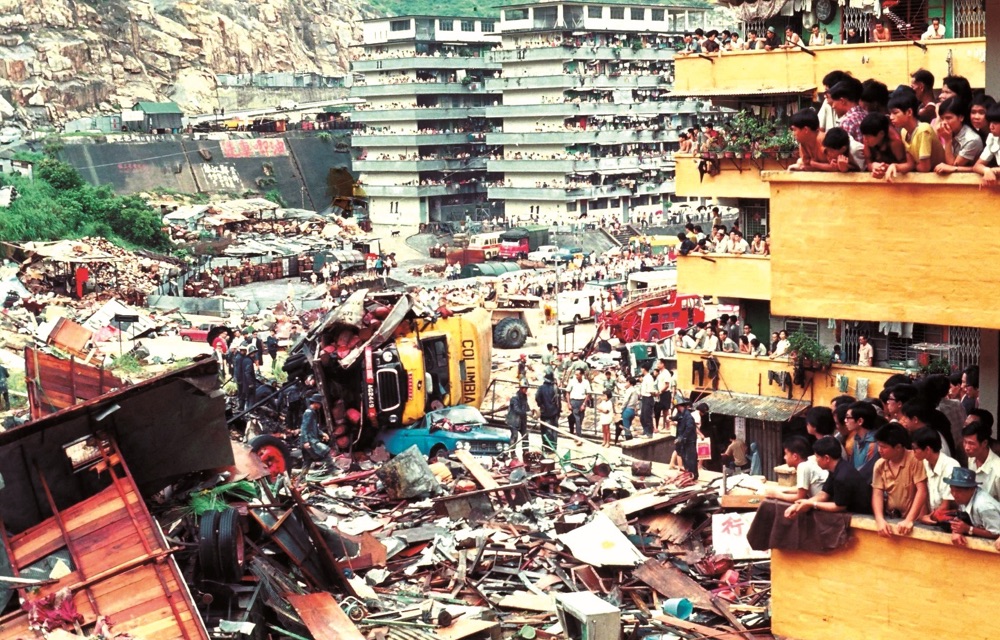
秀茂坪山泥傾瀉的災區 The landslide disaster area of Sau Mau Ping
禍不單行,當晚接近九時,港島半山寶珊道附近一幅天然山坡突然崩塌。泥石帶着巨大動能捲走旭龢道11號一幢六層高建築物,並繼續衝向12層高的旭龢大廈,將它徹底摧毀。倒塌的旭龢大廈撞上旁邊一幢未入伙的建築物,將它最高的四層削去。整場山泥傾瀉持續不足十秒,67人被奪去性命。 The troubles did not end there. Shortly before 9 p.m. on the same day, a natural hillside above Po Shan Road in the Mid-Levels of Hong Kong Island tumbled down. The landslide debris gathered momentum as it washed down, striking a six-storey building at No. 11 Kotewall Road and the 12-storey Kotewall Court, causing both to collapse completely. The collapsing Kotewall Court struck another unoccupied building next to it and shaved off the top four storeys. The landslide, lasting less than 10 seconds, took 67 lives.
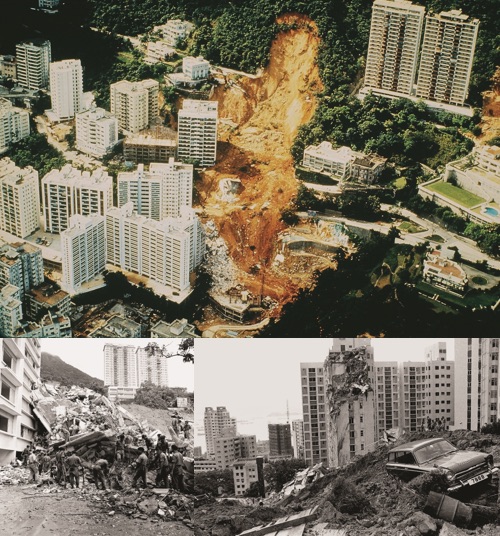
寶珊道山泥傾瀉的情景 The aftermath of the landslide at Po Shan Road
兩場慘劇共導致138人死亡,是本港因雨災引致的單日最高死亡人數。1972年6月18日可說是香港山泥傾瀉歷史上最黑暗的一天。對親歷其境的人來說,那種山崩土淹、地動山搖的震撼畫面,至今仍然歷歷在目…… The two tragedies resulted in 138 deaths, the highest fatalities in a single day in our city due to rainstorms. That day, June 18, 1972, was the darkest day in the history of landslides in Hong Kong. For those who lived through it, the landslide was so terrifying that it seems like just yesterday that disaster struck...
 張鵬輝
Cheung Pang-fa
張鵬輝
Cheung Pang-fa
 胡強
Wu Keung
胡強
Wu Keung
 翁舜華(左)與
翁舜華(左)與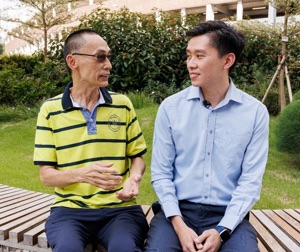
劉蕊與兒子劉斯俊 Michael Lau and his son Samuel Lau
1972年秀茂坪山泥傾瀉災難目擊者劉蕊(當年13歳):「當時見到對面山坡的泥一直把木屋推過來,泥中夾雜着房屋碎片和受災人士,之前的山坡頃刻間消失了。親眼目睹這次災難,令我深深體會到幸福並非必然,兩三秒之間就可以家破人亡,不會再有第二次機會。這五十年間,我見證了香港斜坡安全的進步,明白到背後有很多人在默默耕耘。從任職土力工程處的兒子了解到他們的工作之後,更加肯定了這點。」聽到父親講述當年目睹山泥傾瀉災難事件的親身經歷,求學期間中學老師分享母校的建校過程如何受當年事件影響,不知不覺地在一位年輕人心中埋下種子,令他立志成為土力工程師,為守護香港的斜坡安全、為守護市民的性命和財產出一分力。劉蕊的兒子土力工程師劉斯俊博士說:「我本身對工程有興趣,加上兒時父親和中學老師跟我分享『六一八』的故事對我有所啟發,我就決定修讀土木工程,並在畢業之後加入土力工程處工作。現時我主要負責公眾教育,希望能夠將斜坡安全的資訊傳揚開去,令公眾人士,尤其是年輕一輩,都會時刻注意山泥傾瀉的風險,將知識薪火相傳。我相信我們的工作避免了許多人命傷亡。」 “ I saw the mud from the opposite slope pushing the huts towards us. Debris from the broken huts were washed down together with the victims as the slope disappeared in seconds. Having seen this disaster with my own eyes, I realised we can't take happiness for granted. One can lose his home and family in the blink of an eye and there is no second chance, ” said Michael Lau, who was 13 when he witnessed the tragedy of the Sau Mau Ping landslide in 1972. “ In the past five decades, I've witnessed the improvement of slope safety in Hong Kong. I know many people must have made a lot of effort behind the scenes. After learning what the Geotechnical Engineering Office(GEO)has been doing over the years from my son, who works there, I am even more convinced of this. ” Inspired by the personal experience of his father in the catastrophic landslide and the sharing of his schoolteacher on how the incident affected the construction of his school, a young man made up his mind to become a geotechnical engineer to safeguard the slopes, as well as the lives and properties of the public of Hong Kong. “ I started to develop an interest in engineering when I was a child. Then my father and my schoolteacher shared the tragic story of the 6.18 Landslide Disaster with me, ” said Dr. Samuel Lau, a geotechnical engineer and son of Michael Lau. “ I decided to pursue a career in civil engineering and joined the GEO after graduation. I am currently responsible for public education. I hope to spread the word about slope safety to the public, in particular young people, so that they can always stay vigilant about landslide risks and pass on the knowledge to the next generation. I believe our work has effectively prevented tragedies from happening and save lives.”
土力工程處處長張偉文博士闡述「六一八」事件的成因:「秀茂坪塌下的山坡在60年代其實是一個山谷,後來在附近找來泥土填成山坡。當時沒有岩土工程設計概念,斜坡工程的施工準則和監督亦沒有像現時般嚴謹,估計當時填泥非常鬆散。連場大雨之下,液化了的泥土就好像地氈一樣滑下。而寶珊道對上是一幅天然山坡,山坡倒下的時候就好像滾雪球一樣,最後有約2萬立方米的泥石沖了下來。我們的調查找出了三大成因:首先是山坡的土質容易讓水滲透,其次是罕見的持續大暴雨令地下水位急升,而最後是附近一個建築工地正進行深層挖掘,支撐不足令泥土下墜。」 Dr. Raymond Cheung, Head of the GEO, explained how the 6.18 Landslide Disaster happened. “ The collapsed slope at Sau Mau Ping was a valley in the 1960s and became a fill slope afterwards. As people didn't have much idea about geotechnical design and the requirements for slope works were not as stringent as they are nowadays, we can assume that the soil was very loose at that time. After continuous downpours, the soil became liquified and slid down like a carpet. As for Po Shan Road, it involved a natural hillside. When it collapsed, it gathered momentum and the situation snowballed. As much as 20,000 cubic meters of mud was washed down. According to the investigation after the incident, there were three causes. First of all, the soil was highly permeable. Secondly, the unusual continuous downpours gave rise to a surge in the groundwater level. Lastly, a construction site nearby was conducting deep excavation works and the lack of adequate support caused the soil to collapse. ”
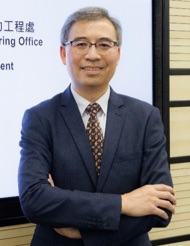
四年後,另一宗山泥傾瀉慘劇於1976年8月25日再次在秀茂坪發生。在熱帶風暴愛倫吹襲之下,天文台在兩天內錄得約500毫米雨量,秀茂坪邨第9座後面的填土坡在早上9時左右塌下,釀成18人死亡的慘劇;該處與1972年慘劇的事發地點相隔只有約200米。 Four years later, another deadly landslide occurred at Sau Mau Ping on August 25, 1976. Hit by tropical storm Ellen, Hong Kong saw roughly 500 mm of rainfall in two days. At around 9 a.m., the fill slope behind Block 9 of Sau Mau Ping Estate collapsed, killing 18 people. The landslide was only 200 meters away from the site of the 6.18 Landslide Disaster in 1972.
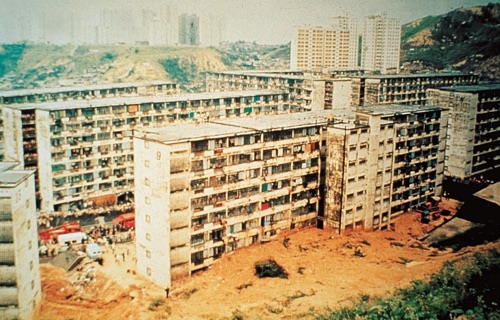
山泥傾瀉過後留下一片泥海 The landslide left behind a sea of mud

鑑於山泥傾瀉的悲劇時有發生,政府於1977年成立土力工程處,專責斜坡安全的工作,務求減低山泥傾瀉對市民大眾生命的威脅。 In view of the frequent occurrence of landslides, the government set up the Geotechnical Control Office(later renamed as the Geotechnical Engineering Office) in 1977 to focus on slope safety, with a view to minimising the threats posed by landslides to the lives of the public.
前土力工程處處長陳健碩工程師講述當時的首要工作:「當年沒有監管岩土工程的法例或斜坡安全標準。處方在1979年出版了第一版的《斜坡岩土工程手冊》作為標準的『天書』。我們亦於1980年訂立法例,規定私人業主鞏固危險斜坡,並在新建斜坡時須提交圖則以供審批。」
Raymond Chan, the former Head of the GEO, talked about their priorities when the office was first set up. “ In those days, there was no legislation or standard for regulating geotechnical works or slope safety, ” said Chan.
“ The first edition of the Geotechnical Manual for Slopes was published in 1979 as a slope safety standard. We also enacted legislation to deal with private slopes in 1980, requiring private landowners to upgrade dangerous slopes and submit plans for approval before new slopes can be built. ”
